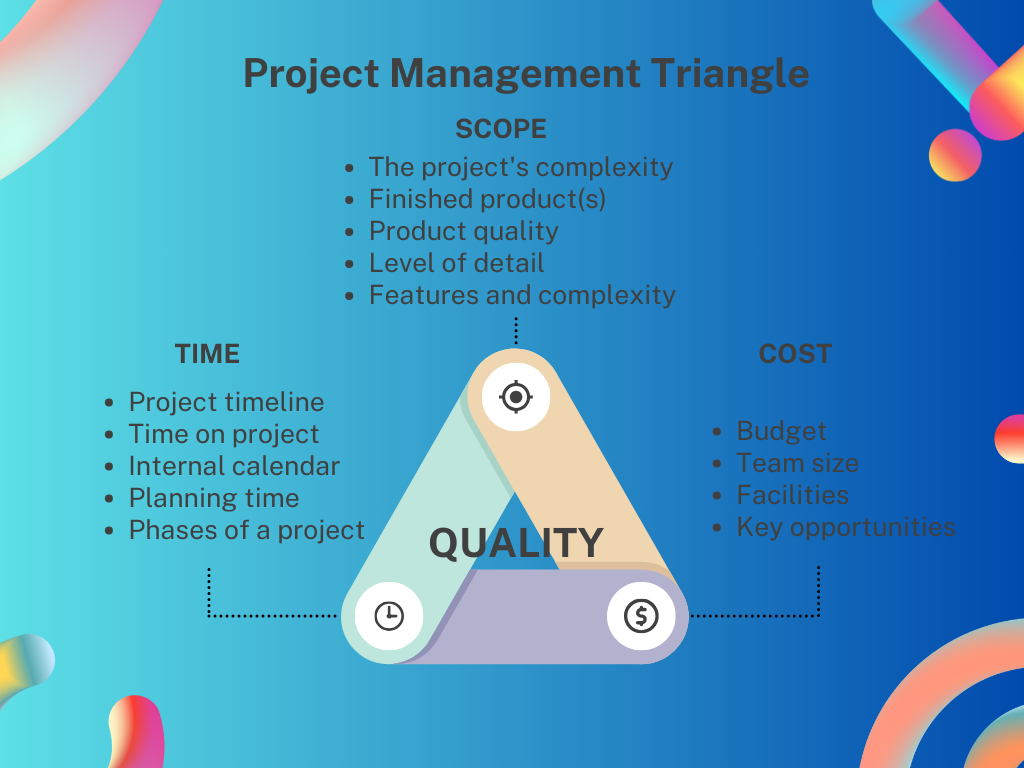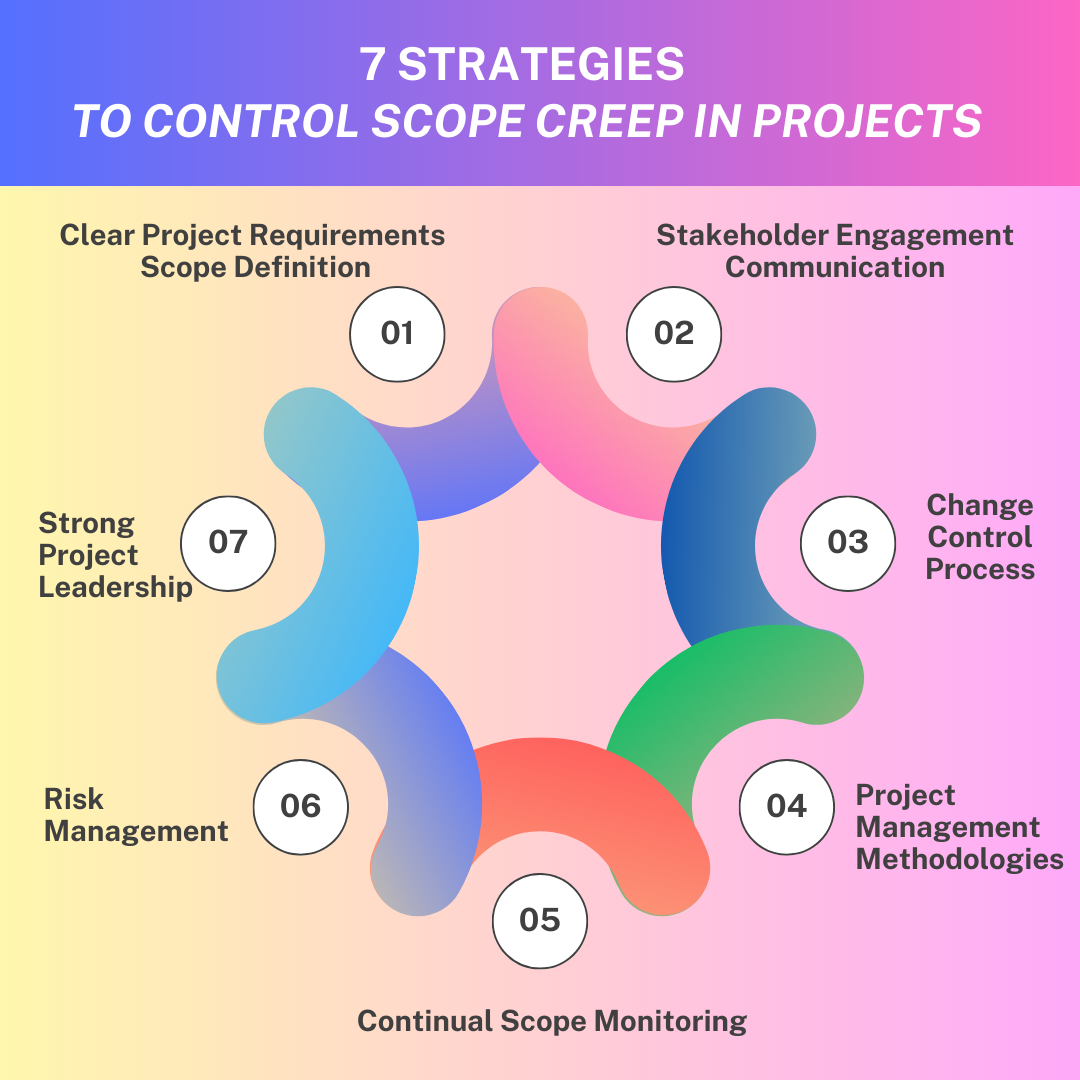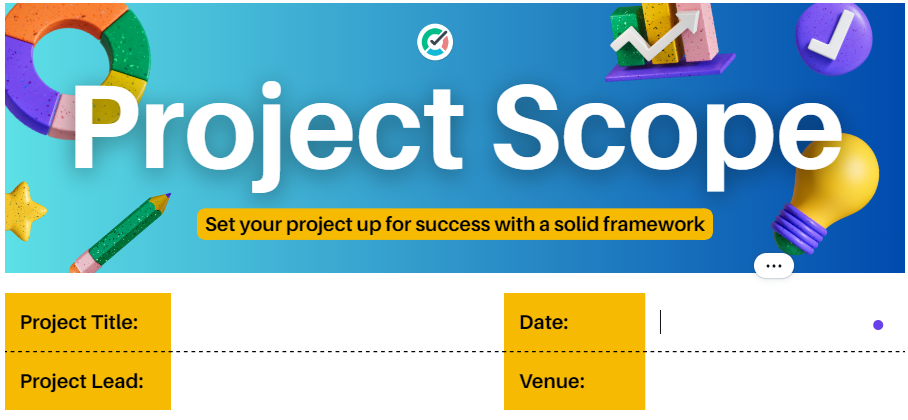The Best 7 Strategies to Control Scope Creep in Projects
Managing scope creep is crucial in project management. Explore the top 7 effective strategies to control and prevent scope creep in your projects for successful delivery.

The project management triangle, also known as the triple constraint, consists of three interconnected components:
- Scope
- Time
- Cost

Understanding Scope Creep
The scope creep meaning implies the project's goals, deliverables, and requirements, outlining what must be achieved.
The scope serves as a blueprint, establishing the boundaries and expectations for the project.
It means that the well-defined scope:
- guarantees that all parties involved have a shared understanding of the project's goals and objectives
- functions as a vital control tool for preventing budget overrun and resource strain
- guides project tasks and decision-making processes, including requirement extensions
- ensures control change with efficient project governance
- guarantees that the project's outcome aligns with organizational objectives and stakeholder expectations.
What is Scope Creep?
Scope creep transpires in the case of gold plating when the project's scope is expanded without proportionate changes in time, cost, or resources, frequently resulting in:
- delayed completion
- budget exceedances
- compromised quality.
Project management faces diverse challenges, with scope creep posing a significant risk as it can lead to uncontrolled deadline extensions, increased costs, and project failure.
Hence, controlling and preventing scope creep in project management is crucial for successfully delivering projects within their designated timeframes and budgets.
What are Scope Creep Scenarios?
Project scope creep occurs when new elements or requirements are added to an initial plan without equivalent increases in resources, time, or budget.

It should be noted that scope creep examples aren't always negative. Sometimes, incorporating valuable new features or adapting to changing circumstances can be beneficial.
However, it's crucial to be aware of the potential negative impacts and proactively manage them to ensure project success.
The scope creep might be due to a variety of factors.
Communication problems
- Unclear or poorly documented scope: If the project's scope isn't clearly defined and documented from the outset, stakeholders risk having different interpretations of what's included and excluded.
- Poor communication between stakeholders: When stakeholders aren't informed about project progress and potential challenges, they may miss opportunities to provide feedback, increasing requests for last-minute changes and disrupting the planned schedule and budget.
- Not addressing change requests effectively: Not having a defined protocol for evaluating and prioritizing change requests can lead to ad hoc decision-making, resulting in inconsistent handling of changes, increased project complexity, and a higher likelihood of negative scope creep impacting timelines, costs, and resource allocation.
Project management issues
- Unrealistic expectations: Setting unrealistic deadlines or budgets can cause scope creep as the team struggles to meet these expectations.
- Poor project planning: Without a well-defined plan for managing time, resources, and risks, it's difficult to control the project's scope and prevent creep.
- Lack of change management: Not having a process for managing changes effectively can lead to confusion, rework, and delays.
External factors
- Evolving market conditions: Sometimes, changes in the market or competitive landscape may necessitate changes to the project's scope to remain relevant and competitive. However, such changes must be carefully considered regarding time and resource allocation to avoid project delays and overruns.
- Technical challenges: Unexpected technical issues can require extra work, which can affect the project's original plans and deadlines.
How to Avoid Scope Creep?
To manage it effectively, there are strategies to prevent scope creep that mitigate these risks effectively.
Here are seven of the best ones.

Strategy #1: Establish Clear Project Objectives and Scope
- Begin with a clear and unambiguous definition of the project's scope.
- Include specific deliverables, deadlines, and requirements.
- Understand and clearly articulate the project's objectives and expected outcomes.
- Identify the specific tasks required to achieve these goals.
- Draft a comprehensive scope statement that captures all project details.
- Outline the project constraints and any assumptions.
- Edit and proofread to ensure this document is the foundational agreement for project execution.
💡 Refer back to the scope statement regularly during project meetings to ensure alignment with objectives. Use visual aids like flowcharts or diagrams to illustrate the project scope and objectives for better stakeholder understanding.
Strategy #2: Engage Stakeholders and Sponsors Actively
Communicate the Project Scope to All Stakeholders
- Ensure stakeholders know the project scope, including team members, clients, and management.
- Clarify what is included and what is excluded from the project scope.
💡Use clear, non-technical language in written communications and visual presentations to ensure understanding across diverse stakeholders. Schedule Q&A sessions to address any clarifications.
Involve Stakeholders in Decision-Making
- Engage stakeholders in discussions regarding any changes to the project scope.
- Ensure their input and feedback are considered in decision-making processes.
💡 Set up a structured process for scope change requests that includes evaluation by key stakeholders and decision-makers. To maintain transparency, use a digital platform for tracking and discussing these changes.
Engage with Stakeholders Early and Regularly
- Initiate engagement with all stakeholders early in the project lifecycle and maintain regular contact throughout.
💡Establish regular update meetings or status reports to keep stakeholders informed. Utilize collaborative tools for continuous communication and document sharing.
Maintain Effective Communication Channels
- Implement effective communication channels and provide regular updates to stakeholders.
💡Use project management software that allows for easy updates and visibility into project progress for all stakeholders. Encourage open lines of communication for raising concerns or suggestions.

Strategy #3: Implement a Change Control Process
Prioritize Changes Based on Impact
- Evaluate changes based on their significance to the project's objectives, timeline, and budget.
💡Develop criteria for prioritizing changes, such as impact on project goals, cost implications, and required resources. Use a scoring system to objectively assess the importance of each change request.
Establish a Formal Change Control Process
- Implement a structured process for managing changes to the project scope.
- This should include a change request form for documenting proposed changes and a change control board (CCB) responsible for reviewing and approving these changes.
💡 Ensure the change request form captures all necessary information to make informed decisions, including the rationale for the change, expected benefits, and potential impacts. Regularly schedule CCB meetings to address change requests promptly.
Prioritize Requests for Additional Work or Features Ruthlessly
- When requests for extra work or new features arise, assess them critically to decide which requests align with the project's core objectives and which do not.
- Concentrate on completing the most crucial aspects of the project first. Postpone non-essential tasks or features to later project phases or iterations.
💡 Maintain open communication with stakeholders about why certain features are prioritized over others.
Strategy #4: Use Project Management Methodologies
- Choose project management methodologies and tools that align with your project's specific nature and requirements.
- For projects that benefit from flexibility and frequent reassessment, consider Agile methodologies.
- For projects that demand stringent control and have well-defined stages, traditional methodologies like Waterfall, implying detailed planning and sequential execution, may be more suitable.
💡Assess the project's key characteristics, such as complexity, stakeholder needs, and delivery timelines, to determine the most fitting project management approach. To enhance project tracking and management, incorporate tools that support the chosen methodology, like Kanban boards for Agile or Gantt charts for Waterfall.

Strategy #5: Conduct Continual Scope Monitoring
Monitor Changes to the Project Scope:
- Keep track of any changes to the project scope, ensuring each change is properly documented, approved, and implemented.
💡Employ a digital project management system that features change tracking and notification capabilities to keep the team and stakeholders updated in real time.
Consistently Revise the Project Plan
- Conduct frequent reviews of the project plan to incorporate any scope changes.
💡Schedule regular project review meetings to discuss progress, review the impact of any scope changes, and adjust the project plan accordingly.
Review Project Progress Against Defined Scope
- Perform systematic continuous reviews of the project progress, focusing on task completion, resource utilization, and adherence to the planned timeline and budget.
💡Implement a dashboard within your project management software to visually track progress against key milestones, budget expenditures, and resource allocation. This will allow for a quick overview and detailed analysis when needed.
Strategy#6: Assess Risks
Identify Potential Risks Early
- At the project's outset, identify potential risks, including those that could lead to scope creep.
💡Conduct a thorough risk assessment session with your project team and stakeholders to brainstorm and document potential risks. Structure this assessment using tools like SWOT analysis (Strengths, Weaknesses, Opportunities, Threats).
Develop Mitigation Strategies
- Develop specific strategies to mitigate each identified risk. This might include contingency planning or allocating reserves for time and budget to handle unexpected changes.
💡Create a risk register that details each risk, its potential impact, the likelihood of occurrence, and the planned mitigation strategies. Assign ownership of each risk to a team member for monitoring and response.
Regularly Review and Update the Risk Management Plan:
- Continuously review and update the risk management plan to incorporate and address new risks as they emerge throughout the project lifecycle.
💡Schedule regular risk review meetings as part of the project schedule to reassess existing risks and identify new ones. Update the risk register accordingly and ensure mitigation strategies are executed or adjusted as needed.
Strategy#7: Provide Strong Project Leadership
Effective Leadership for Focus and Direction
- Project leaders must possess strong leadership qualities to maintain the project's focus and direction.
- They should be skilled in negotiation and conflict resolution to manage stakeholder expectations and align them with the project's objectives.
- Leaders need the ability to make difficult decisions about accepting or rejecting changes, always prioritizing the project's best interests.
💡Develop leadership skills through training and practice in negotiation, strategic decision-making, and conflict resolution. Foster an environment of open communication and transparency to facilitate stakeholder alignment.

Say "No" When Necessary
- It is essential to be able to say "no" to requests that are outside the project scope.
- When declining requests, be firm yet polite. Explain clearly why the request does not align with the project's objectives or would compromise the quality of the final product.
- Offer alternatives or suggestions for addressing the requested changes or functionalities in future project phases or separate projects.
💡Prepare a template or guidelines for politely declining out-of-scope requests that suggest alternative solutions. This approach helps maintain positive relationships with stakeholders while keeping the project on track.
How to Mitigate Scope Creep with TMetric

TMetric time tracking software empowers you to combat negative scope creep in 5 actionable steps.
Track time accurately: Identify tasks exceeding initial estimates and discuss potential scope creep early.
Monitor project workload: Use resource management tools to visualize team capacity and prevent assigning tasks that might strain timelines.
Set clear time budgets: Allocate specific timeframes for tasks and track deviations promptly, flagging potential changes needing approval.
Document change requests: Log and assess every deviation from the initial scope, highlighting their impact on time and budget before implementation.
Generate detailed reports: Gain insights into project progress and resource utilization, proactively identifying areas prone to scope creep.
By leveraging TMetric time tracking and project management features, you can gain critical data to address scope creep before it derails your project.
Concluding Thought
By employing these strategies, project managers can better control scope creep:
- ensuring that projects are delivered successfully
- meeting the project objectives
- avoiding unnecessary overruns or compromises.
While each project may necessitate a unique application of these strategies, tailored to its distinct features and obstacles, these approaches remain universally effective across all project types.


